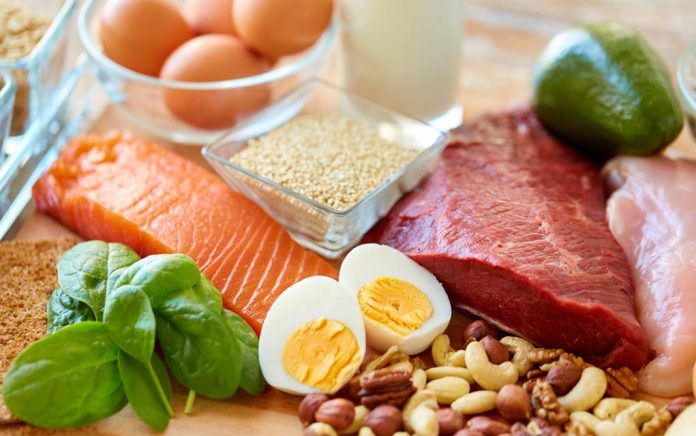
(HealthyResearch.com) – We may remember our elementary school lessons about protein power. While Popeye got his strength from gulping down cans of spinach, our bodies need protein for healthy muscles and metabolism.
Figuring out the best protein sources may seem overwhelming. Products ranging from meal bars to meatless hot dogs boast on their labels “Great Source of Protein.”
We’re here to give you the facts. Learn about the 5 healthiest and 5 unhealthiest proteins below.
5 Healthiest Proteins
Should you cheer or jeer for chicken, beef, fish, tofu, eggs, and dairy? Many factors go into determining the quality of our protein.
One factor involves how our body absorbs the nutrients in protein, known as bioavailability. Bioavailability also includes the amino acids in the protein and how easily our body digests that food.
Another consideration is sustainability. By looking at the effect of our protein sources on the planet, we can choose ecologically healthy foods.
Here are the 5 healthiest sources of protein with those factors in mind:
- Seafood: Fish offers high-quality nutrition, as well as sustainability. For example, 3 ounces of eco-friendly salmon features 22 grams of protein, B vitamins, selenium, and omega-3 fatty acids. These components boost our brainpower, assist overall health, and reduce inflammation.How to Buy: Visit the Monterey Bay Aquarium’s Seafood Watch to get fish ratings based on environmental health factors.
- Chicken: Protein-rich chicken provides both B vitamins and selenium. Enjoy 3 ounces of chicken to take in 21 grams of protein.How to Buy: When possible, opt for organic poultry. Chicken with an organic label typically is more eco-friendly.
- Greek Yogurt: Yogurt has come a long way from the days when we wrinkled up our noses at the mere idea of the sour stuff. A popular choice among vegetarians seeking non-meat protein sources, Greek yogurt contains 15 to 20 grams of protein per 6 ounces. Yogurt also is an excellent source of calcium.How to Buy: Avoid the pre-sweetened, artificially flavored versions. Add your own fresh fruit or spices to non-fat or low-fat plain Greek yogurt.
- Low-Fat Cottage Cheese: Just like yogurt, cottage cheese offers a rich source of protein to those seeking meatless meal options along with calcium. Just 4 ounces gives us 13 grams of protein.How to Buy: Check the label carefully to skip varieties with added, sweetened fruit or preserves. Trying to cut down on salt? Look for “no salt added” or low-sodium cottage cheese.
- Eggs: With omega-3 fats, selenium, vitamin D, and B vitamins, eggs should get a prize as the best tiny but mighty protein source. One egg offers 6 grams of protein.How to Buy: Look for pasture-raised or organic eggs. Both varieties offer sustainability, along with protein.
5 Unhealthiest Proteins
Now that we know the healthiest sources of protein, it’s time to learn which ones to avoid. Steer clear of these unhealthy protein options:
- Protein Powders and Bars: Protein bars and powders may seem like convenient, healthy choices for meals and snacks. But beware. Despite labels promising health benefits, some of these products are high in sugar, artificial sweeteners, and chemicals.What to Do: If you are going hiking and need a protein meal bar, check the label carefully. Seek bars that are low in sugar and high in protein. And if you need a quick meal on the go, consider cottage cheese or eggs rather than protein powder.
- Plant-Based “Meat” Products: Reading the label is the name of the game here. Some plant-based products designed to replace meat contain so much artificial coloring, chemical flavorings, preservatives, additives, and salt that they deserve a quick pass.What to Do: Looking for a meatless or vegan meal option? Consider one cup of rice plus beans, which provides up to 12 grams of protein and 10 grams of fiber.
- Processed Meats: Bacon, hot dogs, sausage, and other processed meats might seem like family-friendly protein sources. However, their saturated fat, preservatives, and sodium are more like health enemies than friends. These meats also tend to be lower in protein.What to Do: Look for chicken or turkey alternatives. Check the label for products lower in sodium and higher in protein.
- Processed Cheese: Many of us learned to cook by removing plastic on pre-sliced processed cheese and plopping it on eggs for omelets or bread for grilled cheese sandwiches. But processed cheese products are often high in sodium, processed oils, artificial coloring, and fake flavoring.What to Do: Go for the real deal, with organic, range-fed cheese as the optimal choice.
- Grain-Fed Meat: Pork, lamb, and beef are high in saturated fat. Red meat products labeled grain-fed also harm the environment.What to Do: Buy grass-fed meat rather than grain-fed. These products contain more omega-3 fats and less saturated fat. Grass-fed meat also is more eco-friendly.
We have many options when it comes to healthy proteins, allowing us to vary our menus and cooking. We might want to take the time to roast a chicken one night and opt for a quick omelet the next evening, for example.
By taking time to understand which healthy proteins to enjoy and which to avoid, we are investing in our health. Choosing eco-friendly, sustainable protein options benefits both our well-being and the health of our planet.
~Here’s to Your Health & Safety!
Copyright 2021, HealthyResearch.com
















